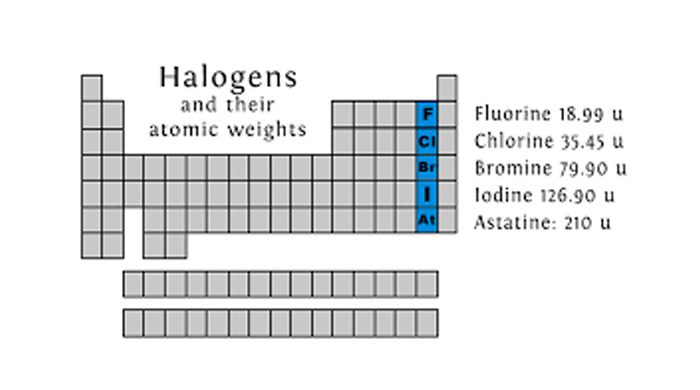Iodine Removes Fluoride From The Body And Serves As A Fluoride Detox

Studies have shown that iodine does displace and remove fluoride, though it is the heavier halogen. The scientific explanation of the halogen displacement suggests that iodine cannot displace fluoride because it is the heavier halogen.
The theory of halogen displacement is the element with the lighter atomic weight can displace the element with the heavier atomic weight, but not the other way around.
Principle of Halogen Displacement
Halogens are a group of five non-metallic elements that combine with hydrogen to make various forms of salts. These halogens are comprised of fluorine, chlorine, bromine, iodine, and astatine. The atomic weight of these halogens are:
- Fluorine: 18.99 u
- Chlorine: 35.45 u
- Bromine: 79.90 u
- Iodine: 126.90 u
- Astatine: 210 u
Fluorine is the lightest element while astatine is the heaviest element.
This displacement method seems logical but there is evidence that shows that displacement theory doesn’t work or it doesn’t work alone and there are other factors at work. Dr. Guy Abraham provided a letter[1] to the Townsend Letter journal that supported iodine’s ability to displace fluoride for urine excretion.
Iodine Does Displace And Remove Fluoride Through Urine
The letter addressed key points of his study and detailed how displacement occurred. Participants in the study were given iodine/iodide loading tests consisting of 2-3 tablets iodine/iodide tablets to determine its ability to displace other halogens. Baselines were determined for halide/halogen excretion without supplementation.
Using 3 iodine/iodide tablets, fluoride excretion increased 17.5 times and bromide excretion increased 18 times baseline. After 1 month fluoride excretion remained at 15 times baseline, and bromide excretion remained at 16 times baseline.
This evidence clearly showed that iodine was able to successfully displace fluoride and remove it from the body through urination, even though it was the heavier halogen.
David Brownstein also conducted a study[2] using iodine/iodide supplementation for the purpose of documenting its effects on fluoride displacement and removal. Brownstein’s study also supported iodine’s ability to displace and remove fluoride.
Iodine Deficiency
Another important result of both studies was the indication that most people were severely deficient in iodine.
“He did not reach iodine sufficiency even after one month on 3 tablets/day. Based on the results of the loading test, the body is considered iodine sufficient when at least 90% of the oral amount is excreted in the 24h urine collection.”[1]
“Although I expected lowered body iodine levels, I was not ready for the magnitude of the results. After testing more than 500 patients with the loading test, I found that 94.7% of my patients are deficient in inorganic iodine.”[2]
Iodine Sources
Whole foods are always the better sources of iodine because they contain a complement of nutrients. Seaweeds are the best sources of iodine which include kelp, irish moss, wakame, dulse, arame, hijiki, and nori. Unfortunately the caution against seaweed is the mercury pollution from industry and the radiation from Fukushima entering the Pacific ocean and traveling to the west coast of America. Seaweed absorbs this pollution and radiation, so it is best to get seaweed from the Atlantic.
If your choice is short-term supplementation nascent iodine appears to be the better form of supplementation than the use of potassium iodide tablets.
[1] Iodine Supplementation Markedly Increases Urinary Excretion of
Fluoride and Bromide
[2] Clinical Experience with Inorganic, Non-radioactive Iodine/Iodide
More Fluoride Information:
- Tamarind Fluoride Detox
- Link Between Fluoride And The Calcification Of The Pineal Gland
- What Is The Role Of Fluoride In The Body?
- Fluoride And The Pineal Gland
- Boron Fluoride Detox To Combat Skeletal Fluorosis And Decalcify The Pineal Gland






